When we say fish finder today we usually mean sonar, map navigation with depth contours, radar, side scan, 3D-images, and autopilot. Almost all users want a quality navigation display and a detailed sonar display with their fish finder.
The clarity of a sonar depends both on the power of the transducer and the frequency in which it is used. Relatively new CHIRP Technology allows for a range of frequencies to be swept simultaneously to allow for accurate feedback at both shallow and deep depths. Typically there was a high-frequency band around 200 kHz with a wide beam that was good at finding fish in less than 100-200 feet of water. A lower frequency signal around 50 Khz signal has a more narrow beam and works well at finding fish and structures below 100-200 feet.
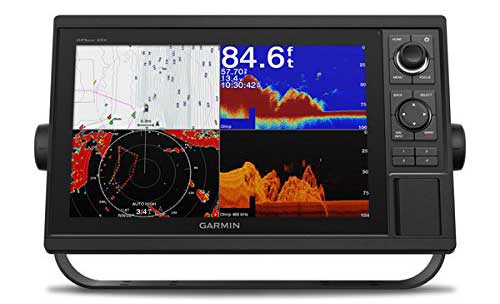
What is the best fish finder really depends on the type of fishing being done and the other technology like radar and autopilots that needs to be compatible with the unit. As a charter captain, I like to have the state of the art electronics. Having good electronics is really helpful when you are on a boat for 12+ hours a day. In Alaska having a radar is basically required and having autopilot integrated makes trolling offshore possible without a deckhand.
The sonar itself is helpful in locating, bait, structure temperature breaks, and fish. Sonar is especially helpful when fishing for fish that stay near the bottom like, salmon, walleye, crappie, and rockfish.
In many cases, fish finders cost thousands of dollars more just to get a larger display. For this reason, it is important to know what features are included and not just assume that a more expensive unit is better.
Here Are The Best Fish Finders
1. Simrad NSS or NSO evo3s Fish Finder
Estimated Price: $2,240-$12,200
The Simrad NSS evo3s comes in 9-inch, 12-inch, and 16-inch sizes. Simrad’s NSO evo3s display is 16-inch, 19-inch, or 24-inch. The NSS version is a powerful unit with the SolarMax IPS display, six-core processor, 1kW Chirp Sonar, and advanced networking options. This version is a top-of-the-line unit that is great for most recreational and professional anglers. It can be in integrated with autopilots, radar, sonar, and smartphone devices.
The NSO version is typically installed in luxury yachts and has the option to be integrated with the NSO eveo3s processor. It has the iMX 8 high-performance processor. The main reason to get the NSO version is the get the larger 19-inch or 24-inch displays, however, these larger sizes are significantly more expensive.
I use the NSS unit on our flats boat in the Florida Keys. In the video below I discuss why this is the best fish finder on the market. We have Florida Fish Tracks installed which provides detailed terrain maps that allow for easy navigation through channels and shallow water. As I looked around at the Fort Lauderdale boat show I was also surprised to see these unites of many mega yachts such as Sunseeker yachts. So this fish finder is versatile enough to be the best on an 18-foot flats boat or an 80-foot luxury yacht.
In the video above I explain why Simrad makes the best fishing finder. This fish finder is a 16-inch Simard with the Florida Marine Tracks chip installed. The chip shows the best path to travel on during high and low tiedes. This makes navigating in shallow water much easier.
Simrad also has C-MAPS and CMOR relief shading that shows the 3D structure of the bottom. This does need to be purchased separately on a chip. Garmin also has relief shading apps but CMOR mapping can not be used on a Garmin device. In the past, I would recommend Garmin as the best fishing finder. However, I think that Simrad has taken over and is the best in terms of navigation, sonar quality, and ease of use.
2. Simrad GO9 GO12 XSE with Sonar Transducer Package
Estimated Price: $700-$2,550
This Simrad GOfish finder series comes in a 5-inch, 7-inch, 9-inch, and 12-inch display versions. The transducer included is the active image 3 in 1. It is able to get data for side scan, down scan, and CHRIP. The display can show up to four screens at one time. This is nice as the chart plotter navigation can be used in conjunction with the sonar and side-scan. Using these at the same time is a quick way to locate and mark underground structures and wrecks that are holding fish.
Radar can be integrated to track weather and navigate in foggy conditions. A phone or tablet can be connected wireless to the unit. This allows the screen to be displayed in more than one location on the boat. Often time anglers have to buy two full systems just to get the display in two locations. Using a phone or tablet is nice just make sure to run power to the screen when using it on long trips.
3. Garmin GPSMAP 743 943 1243 with Touchscreen
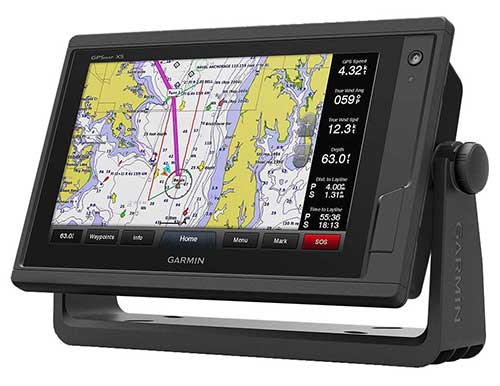
Estimated Price: $1,100-$2,900
The Garmin GPSMAP comes with a 7-inch, 9-inch, or 12-inch touch screen display. There is a large price difference based on screen size as the 7-inch retails for around $1,100 the 9-inch is around 1,400 and the 12-inch costs around $2,900. This unit is compatible with radar, weather, sonar, VHF, camera, wind sensor, and AIS. On the back of the unit, there is an NMEA 2000 connection that allows this unit to work with autopilots.
The GPSMAP 743xsv, 943xsv, or 1243xsv is the newer model of the GPSMAP 742xsv, 942xsv, or 1242xsv which were very popular models. The new versions have a higher screen resolution and processor that is almost twice as powerful. If you get the xsv versions the unit will work with Sidevu, Clearvu, mapping, and traditional sonar which are all typically included. There is an xs or standard version that is significantly cheaper that uses the traditional CHIRP and downVu sonar which is typically not included with the purchase.
The touchscreen series of Garmin fish finders are my favorite to use. As a charter captain if I was buying a boat I would get a Garmin with a 12-plus inch display. My favorite features of this device are the basic fish finder capabilities and easy-to-use navigation. With the touch screen, you can just tap the screen where you want to go on the map and hit goto. If an autopilot has been integrated taping the engage button will drive the boat straight to that location. The navigation charts are very detailed and are a must-have when navigating in shallow water areas.
I always wondered if would I rather have buttons and a knob or a touch screen. Often times when fishing my hands are wet and slimy. However, after using both for long periods of time I have concluded that having a touch screen is way nicer! When fishing inshore or offshore this is a powerful unit to have on the boat.
4. Garmin GPSMAP 86 Series with Transducer
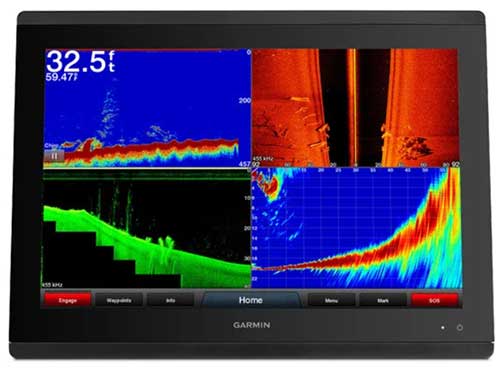
Estimated Price: $2,800-$12,000
The Garmin 86 series are the best marine chartplotters that Garmin makes. The modes are 8610, 8612, 8616, 8617, 8622, and 8624 for 10-inch, 12-inch, 16-inch, 17-inch, 22-inch, and 24-inch sizes respectfully. The actual diagonal display dimensions are a bit smaller than the unit size given.
Differences between the 1242xsv and the 8612xsv are mainly the screen resolution and types of transducers that can be used. The 86 series units have a full HD 1920 x 1o80 display compared to 1280 x 800 pixels for the 1242xsv. Also, the 86 series can use the ultra high definition transducer for improved sonar clarity.
The larger screen sizes cost significantly more money. For example, the 10-inch version retails for around $2,700 while the 24-inch version cost around $12,000. The reasonable price point with an easily viewable display seems to be the 12-inch display for around $3,500 which is very popular. I know of several boats that mount two 12-inch units side by side near the driver’s seat and have an additional 12-inch display near the rear of the boat to view while trolling with downriggers. If you spend a lot of time using the fish finder and navigation it very well may be worth paying more for the large display sizes. The best size display is based on the vessel, user preference, and budget.
5. Garmin EchoMap UHD Fish Finder
Estimated Price: $700-$2,950
The Garmin EcoMap UHD fish finder comes in 4-inch, 6-inch, 7-inch, 9-inch, 10-inc, and 12-inch color displays. Sv units come with a transducer that works as a side scan, clear view, and CHIRP sonar. The cv units are similar but do not have the clear view option which offers a wider field of view under the boat. It comes with Navionics charts preloaded for US Coastal waters in the ocean. Being able to see depth contours is important for safe navigation and finding fish. The screen can be controlled with the buttons on the right side of the touch screen.
There are several model options to choose from. The 92sv has only a worldwide base map, 93sv has LakeVu g3 Maps with data from 17,000 lakes in the USA, 94sv has BlueChart g3 with US coastal data, and 95sv has data for lakes in Canada.
A power cable and dashboard mount are included. This is a good unit for freshwater or saltwater use. NMEA cables allow for an autopilot to be set up with built-in navigation. This unit is compatible with the Garomin Panoptix Livescope scanning sonar which is an impressible technology. The Livescope is similar to a video camera since it shows a constantly updated live display. It points to the side and down and shows the side profile of fish and structure.
6. Garmin Striker Plus 5CV 7CV 9SV and Striker Vivid
Estimated Price: $320-$620
The Garmin Striker Plus has a 5-inch, 7-inch, or 9-inch color display that is readable in sunlight. This is a similar model to the striker 4 plus but instead of having the buttons underneath the display, this model aligns them on the right-hand side with a wider screen. There is also a new striker Vivid option on the market which offers new color palettes. It is basically the same as the Striker Plus but you can change to the color of the screen if you want.
The display is capable of split-screen viewing configurations and includes split-screen zooming. Of course, you’ll be getting your hands on that sweet Garmin ClearVU scanning technology which allows for incredibly concise and clear downward imaging, capable of creating imaging contours at 1-foot margins.
Furthermore, you’ll get the power of Garmin 5Hz GPS which is capable of being used as a split screen with your fish finding or imaging display.
7. Garmin Striker Plus 4 and Dual Beam Transducer Package
Estimated Price: $140-$160
The Garmin Striker Plus 4 has a 4.3-inch color display. This is the same Striker we love from the previous review with a slightly larger and better contract display and a dual-beam transducer set-up, meaning you can use the CHIRP equipped sonar that sweeps through 50/77/83/200 kHz.
Fish finds are especially helpful at marking fish that live to near the bottom like salmon, walleye, crappie, and rockfish. For fish that do not swim in schools and or near the bottom, fish finders are most helpful to locate baitfish that predator fish might be feeding on.
This model is a bit better for those of you wanting a bit more control over the sonar configuration. Like the Striker 4 base model, this one includes the Garmin ClearVU-3D scanning function and also utilizes a 6-button layout, just in a slightly larger form factor.
8. Garmin Striker 4 and CHIRP Transducer Package
Estimated Price: $140
The Garmin striker comes in 3.5-inch, 5-inch or 7-inch color displays with waterproofing. The CHIRP transducer uses 77 kHz-200 kHz sweeping frequency band with a maximum depth of 1600 feet.
If you just need a sonar unit in depths less than 50 feet this is a great low-cost fish finder that will mark fish and shop accurate depth. A major leader in the fish-finding tech sector is Garmin, which means you’ll see several of their top models on this list, and for good reason, they’re well made and priced fairly.
The Striker 4 is incredibly cheap at just above a hundred bucks but manages to include a very user-friendly GPS system and a very powerful CHIRP transducer. It’s affordable, it has what you need, and it gets the job done well with an adjustable transducer that’s capable of fitting the bill in most casual situations.
This particular unit also comes with the Garmin ClearVU scanning function and an easy-to-use mount. A six-button set on the unit is easy to use and it even comes with a built-in flasher for ice fishing or vertical jigging.
In the video below the Striker 4 is compared to the striker plus 4. The striker plus 4 plus is reviewed as option 7 in this article.
9. Humminbird Helix 12 and 15 CHIRP Side Scan and Down Imaging
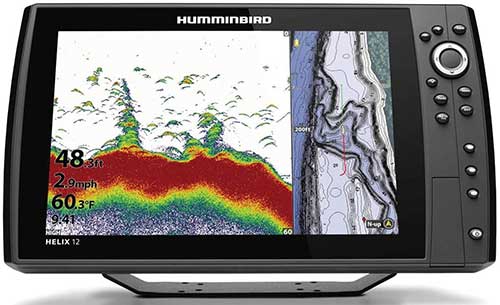
Estimated Price: $2500
The 12-inch and 15-inch Humminbird Helix is a top-of-the-line fish finder for freshwater fishing. It is controlled with the buttons on the right side and is not a touch screen. The large 12 to 15-inch screen allows the user to see the great imaging options of the unit in proper detail. These imaging features include Mega side imaging, Mega down imaging, CHIRP, Chart with GPS location, and maps with depth contours. The transducer, wiring harness, and bracket for mounting the fish finder are included.
This is a fish finder used by Bass fishing professionals. It can be mounted at the front of the boat near the bow mount trolling motor or near the dash by the searing wheel. The Chirp sonar and down imaging allow fish and structure to be easily seen directly below the boat. Side imaging allows for more area to be viewed which results in more likely find the structure that is holding fish. Using the maps with depth changes is a good way to find drop-offs and ledges that often have high concentrations of fish. Another similar unit that is also good is the Humminbird Solix 15.
10. Humminbird Helix 7 CHIRP GPS G4N
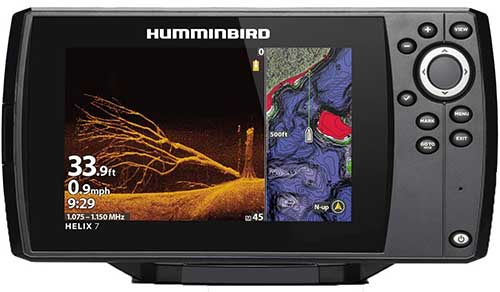
Estimated Price: $720-$930
The Helix 7 CHIRP Mega Down Imaging package from Humminbird has a 7-inch sunlight-readable display. This unit comes equipped with a powerful GPS receiver that offers your choice of storing 2500 waypoints and 50 different custom routes. The fish finder also comes equipped with an expandable storage slot fit for a single Micro SD card, in case that 2500 waypoints weren’t enough! To boot, the unit comes with Lake Master, Auto Charting Pro, and Navionics+, which work great for navigating and charting needs.
The G4N version is different from the G4 version because it has advanced networking and includes Mega Live Imaging, dual micro SD slots, ethernet networking, ipilot link, wi-fi, and chirp radar. If these are not features you plan to use the G4 version is significantly cheaper.
11. Humminbird Helix 5 G3 CHIRP Chip Package
Estimated Price: $310
The Hummingbird Helix has a 5-inch multi-view display with a tilt mount included. Expandable SD memory allows for additional waypoint and map storage.
You’ll get built-in GPS capabilities, Humminbird’s 2D low-power sonar system, SwitchFire detailed bottom charting, both wide and narrow beam configurations, and a powerful 4000W sweeping frequency CHIRP transducer capable of both down imaging up to 2500 feet and clear side imaging.
Humminbird has a nice little collaboration with LakeMaster and NOAA that allows them to include powerful base maps from the most trusted fishing sources. With Humminbird’s powerful Live Autocharting feature, you can record up to 8 hours of custom charting, all recorded seamlessly as you travel around.
12. Lowrance HDS-12 Live Fish Finder
Estimated Price: $3,500
This unit comes in 7-inch, 9-inch, 12-inch, and 16-inch sizes. The features of this unit include StructureScan 3D, StructureScan HD, Mercury VesselView Link, and Lowrance’s Outboard Pilot software.
The Lowrance HDS-12 Live is fully capable of integrating with your mobile device via WiFi connectivity and touts the most advanced fish-finding technology to ever hit the market thus far.
The sonar is in a proprietary color scheme that utilizes high-visibility contrast to enhance the usability of its advanced sonar capabilities. Speaking of sonar, this unit does it all, from down and side sonar to full 3D and HD scanning, the quality is unmatched. Of course, it comes with a powerful 10Hz GPS system that supports WAAS, EGNOS, and MSAS. A huge advantage to using this fish finder is its capabilities of tethering together multiple sonar systems to create an all-encompassing 3D image scan. With the HDS-12 Live, you’ll be able to mount multiple different transducers on your watercraft and link them together to create a full sonar network.
13. Lowrance Elite TI2 W Med High Skimmer Transducer
Estimated Price: $2,070
The Lowrance elite series comes with display sizes of 5-inch, 7-inch, 9-inch, and 12-inch. The Elite-12 TI is the premium level of the Lowrance lineup. Here you’ll find those make-or-break functions that are more than worth the money if you’re serious about fishing. Let’s start with one of the biggest difference-makers here – the transducer.
Lowrance has developed its own proprietary CHIRP-equipped transducer called the Med/High Skimmer. This transducer has quickly become a top choice among fishermen from both the entry-level to the most advanced fishing operations.
This HDI transducer utilizes the power of DownScan Imaging processing and its multi-beam Med/High CHIRP sonar to create powerful photo-like images of structures, fish coverage, and target differentiation.
Something that truly stands out with this particular imaging system is its ability to track and portray each individual fish in a tightly packed school of fish where other units may only be capable of showing a solid mass of blobs. Furthermore, using StructureScan HD, you’ll be able to identify very clearly where and what the fish are congregating around with ridiculous precision and image quality.
The actual display is a beautiful and touch-capable 12-inch monitor with Trackback software, allowing you to review historical data no longer displayed on the unit. This allows you to easily compare and return to areas of interest and since the Elite TI comes with intuitive navigation tools, you’ll be finding and saving the locations of each and every one of the best fishing spots!
The system as a whole is highly connective with full mobile phone integration via WiFI and Bluetooth connectivity. You’ll have access to MotorGuide Xi5 trolling motor software, C-MAP Genesis updates, Power-Pole Anchors, SonicHub 2 marine audio, and more. Furthermore, your system can connect with NMEA 2000 to provide instant access to engine monitoring software, waypoint location sharing, and SmartSteer trolling navigation.
It’s important to note that there are smaller and less expensive Elite models available, but some may lack the features of the larger units, such as the Elite 5 TI not having MotorGuide control.
14. Lowrance Hook Reveal
Estimated Price: $270-$935
The Lowrance Hook Reveal is the newer model of the popular Hook-2. This model is an improvement though across the board. The Reval comes in display sizes of 5-inch, 7-inch, and 9-inch. These units utilize the latest SolarMAX high-resolution screens. One of the most intuitive and customizable experiences ever offered in a fish finder, the Reveal was designed around the idea of automatic adjustments.
There are two transducers offered for the reveal which are the SplitShot, and Triple Shot. The TripleShot is the larger traducer and provides DownScan, SiseScan, and CHIRP.
The Reveal comes with very easy-to-use navigational tools including Navionics, GPS plotter, pre-loaded C-MAPs, and a birds-eye view of 1-foot contour lines on over 4000 different bodies of water in the US.
With the Reveal you choose your screen size, transducer type, install, and the unit will automatically adjust its configurations to best match the conditions and type of fishing you’re currently doing. This happens without the need for human intervention.
The SplitShot transducer is a 2-in-1 sonar package that utilizes both CHIRP sonar technology and Lowrance’s advanced DownScan imaging. These work together to form a comprehensive and complete image of all the swimming creatures, bait balls, and structures under the waves.
If the side scan feature is not important for the type of fishing being done I would recommend the SplitShot transducer as it is a smaller transducer. Sometimes large traducers spray water while running if not mounted high enough on the boat.
15. Raymarine Axiom With RealVision 3D and RV-100 Transducer Package
Estimated Price: $1,250-$1,550
The Raymarine Axiom is available in either 7-inch, 9-inch, or 12-inch displays. The features include RealVision 3D image processing, SideVision, DownVision, 3D fish finder, and powerful CHIRP sonar. This is really one of the most feature-rich technologically advanced units on the market today.
It’s powered by a quad-core processor running on the Lighthouse 3 operating system. This multi-touch interface is by far one of the highest resolutions and best overall looking screens I’ve seen in fish finders.
The RV-100 transducer is a CHIRP enabled 600W monster with the option to use a dual beam 50/200kHz frequency configuration. This unit is capable of displaying sonar imaging from the side, underneath you, and in the RealVision format all on the same screen!
The Axiom fishfinder comes with full mobile integration via WiFi connectivity that allows you to transfer and save data and also control most of the features on the unit itself from your smartphone.
You’ll also get Navionics+ charting programs that cover over 20,000 bodies of water in the US and Canada.
Worthwhile mentioning, this thing is absolutely insane when it comes to functionality. You can watch Netflix, stream Spotify, integrate with drones or security cameras, and add more radar functionalities. This is truly a full-service boat media hub that so happens to be highly effective at finding fish! If you don’t mind paying a premium for a beautiful and powerful technological upgrade for your precious watercraft, this is the fish finder for you!
16. Humminbird PiranhaMax 4 DI Down Imaging
Estimated Price: $160-$170
Not as well known as Garmin but arguably of similar quality, Humminbird’s PiranhaMax is a neat little 4.3 inch fish finder. This particular unit focused on downward imaging and touts an impressive 2400w peak power output. Dual-beam down imaging capable of looking down up to 600 feet in a narrow or wide beam angle configuration. There is also the Piranhamax PT which is a protable fish finder that comes in a back where the transducer can mount the the back of a small boat or kayak using a suction cup. It does need to be connected to an external 12 volt marine battery.
Humminbird’s Fish ID+ makes spotting fish a breeze and since there are only 4 buttons, this unit is extremely user-friendly. To make matters even better, its equipped with dual beams, allowing for a fantastically wide range of down imaging.
17. Deeper Pro+ Smart Portable Castable Sonar
Estimated Price: $180-$300
Something a little different here is the Deeper Pro+ castable sonar unit, which is simple to use and extremely effective for those of you fishing from the bank or a kayak. It is capable of casting out 330 feet and scanning to depths of 260 feet The deeper app can store and share information with ease. Bass Pro Shops has the deeper smart sonar with CHIRP.
Like the title suggests, you attach this to your fishing pole, cast it out into the water, and then using the power of WiFi, you obtain all of that sweet information regarding the whereabouts of those pesky fish. But wait, there’s more!
This bad boy has built-in GPS and will automatically build contour maps for your viewing pleasure. Figure out where your favorite lures will get lost BEFORE casting them into oblivion. Of course, you’ll also get depth data, water temperatures, and several other tidbits of important information.
If you buy the gift kit, you’ll get a night cover that lights up your fish finder, a Gerber multi-tool, a tactical-looking smartphone holder, and a nice little carry bag.
Fish Finder Features
Fish finders have come a long way over the years and now they’re packed with tons of extra features. Some are vital to a fishing trip and some simply to make the trip more enjoyable. When shopping for a new fish finder, it’ll be helpful to understand the following terms. Some of these are fantastic additions to a fish finder that you may really appreciate having. Others simply drive up the price of the unit with features you may not actually need. It’s important to keep in mind that some of the following terms may have other names signifying similar technologies that are branded by different manufacturers.
GPS/Navigation
If you have a cell phone with Google Maps then you know what this does. GPS-equipped fish finders allow you the freedom to ditch the distracting cell phone without ditching your trusty navigation tools.
Satellite Radio
Simply put, new age fish finders are including satellite radios to ensure you’ve got access to your favorite stations despite fishing out in the middle of nowhere. We all know that one spot in the lake that seems to have the most fish but is in between two massive hills that block the radio towers. With satellite radio, you won’t need to rely on towers any longer.
Chart Plotting
Chartplotters are handy little tools that are entirely location-based. It’ll show your current location, past locations, historical depth readings, contours, and depending on the chart plotting software installed. These are especially handy in charting specific fishing routes, setting waypoints, marking things of interest or hazards, and remembering hot fishing spots. Recently, chart plotting systems have been aiding in filtering historical information too.
StructureScan
With the implementation of a 3D capable transducer, StructureScan software builds a three-dimensional topographical image of the seafloor. This provides significantly more information about the underwater landscape than a traditional 2D imaging processor. With this feature, you’ll better understand where the fish are located and what they’re hanging out next to. Structure limbs, rocks, caverns, etc. can be viewed. StructureScan is actually trademarked by Lowrance. There are many other similar features implemented by other manufacturers by other names such as the Garmin RealVu 3-D.
Bottom Discrimination
Kind of similar to StructureScan, this allows the fish finder to display the actual makeup of the bottom and determine whether its mud, sand, gravel, or rock. This works by analyzing the strength of the bounces from your transducer to determine hardness. This comes in handy when picking fishing locations, often certain types of fish live on different bottom types.
AutoChart
Features like this can be named many different things, such as Hummingbirds Autochart Live. These allow you to create an entire real-time chart based on the sonar readings to create your own personal detailed view of the bottom. Furthermore, you can use this tool to compare historic maps with real-time data to determine changes and shifts such as a new depression. Maps that are more accurate can be made and compared to look for good fishing spots.
SwitchFire
This is a special image post-processing system that filters out the “noise” in a sonar image. Simply put, this makes the image clearer and easier to gather important information from. This system can also help to process images being interfered with by turbulence.
Post-Gain Processing
A handy little software trick that automatically adjusts the entire image, even historical data, with your new display settings. Traditionally, if you changed a setting on your display, you’d have to wait for new data to pop up before the unit uses your new settings, but with post-gain processing, the unit automatically converts all existing information according to the new configuration.
History Scroll Back
Simply put, this allows you to backtrack over previous data your fish finder has displayed but no longer shows on the screen. Handy for comparing different fishing holes and comparing chart plotter data.
Split-Screen and Four-Way Viewing
Self-explanatory here. Your display will allow you to set up multiple partitions on the screen to display different data sets and monitoring systems.
Wi-Fish
For our social media fiends out there, Wi-Fish utilizes a black-box sounder and pairs this with your transducer and your smartphone to give you full fish finder capabilities in the palm of your hand, ready to share to social media! No more lame photos of the screen of your fish finder, upload high-quality real-time screenshots and share data of your fishing trip to your pals! As a final note, Wi-Fish also lets you scroll back up to 60 seconds on your smartphone, letting you analyze data that may have already disappeared from your fish finders display.
Fish Finder Buying Guide
What is A Fish Finder?
Fish finders are an evolutionary piece of sonar technology that was originally found in the form of a fathometer. The fathometer was widely used for navigation, displaying the water depth, and other general oceanographic information. The root word of the fathometer, the fathom is a unit of measurement for water depth.
Fathometers worked by transforming electrical pulses into sound waves via an underwater transducer (AKA Hydrophone) and using the reflected sound waves to record data, such as size, composition, shape, depth, location, movement direction, etc. The reflection data is gathered using some pretty complex math equations, which we’ll talk about more in-depth in the next section.
The original fathometer used for recreational purposes used a rotating ray of light at the edge of a circle which flashed with every echo received, which is how it showed the user depth. The faster the flash, the closer the bottom was to the boat. In bright light on a sunny day, this was terribly difficult to utilize and to make matters worse, if the waters were rough, they were nearly unusable due to accuracy issues. Furthermore, they gave off brief quick flashes indicating fish, but a quick couple of flashes was all you got in terms of fish finding functionality.
Some really smart oceanography scientists (anglers at heart) realized they could use similar technology to find the location of the creatures swimming under them and display them onto a screen with a limited amount of tracking over time, thus, the modern-day “fish finder” is born.
How Fish Finders Work
This section will be a bit technical, so if you don’t care about the math and science behind fish finders, you could skip this section! If you’d like to learn more about fish finders as to better interpret their data and set yourself apart from the weak anglers, read on!
Starting with math, fish finders use this approximate equation to determine the speed of their manufactured sound waves through water: C = T – T^2 + S + D.
C is the speed of sound (m/s)
T is the temperature in Celsius of the water
S is the salinity per mile (amount of salt in the water)
D is the depth of the water currently being measured
A modern-day fish finder will re-record and calculate this data up to 40 times per second and chart this data on a graph.
We mentioned that the fish finder is sending sound waves through the water to determine the distance and position of fish and the seafloor. How sensitive (the frequency of sound waves) will determine the amount of location accuracy. Using a higher frequency will result in much faster display times and more accurate and more detailed displays, however, higher frequencies penetrate matter with less efficiency, making lower frequency superior for extreme depths. Most instances of commercial fishing such as deep-sea trawling use an optimum range of frequencies in the 50-200kHz, making their display a bit less detailed than what you’d use to go bass fishing.
When looking at the graphical display of your fish finder, it’s important to note that what is in the middle of the screen isn’t always what is directly under your boat. Instead, the x-axis is actually showing time, meaning the left portion of the graph is what your transducer has already passed over and recorded. What’s directly under your transducer is at the far right in most units.
Keeping this in mind, lower-end units fail to track this data accurately at high speeds. If you’re traveling at high rates of speed, the graph may lack data and will be less accurate, creating imaging distortion. Image distortion is heavily based on the speed of your vessel versus the update rate of the fish finder. This means that if you plan on locating fish while on the move, you’ll need to opt for a fish finder that has a high refresh rate, close or at 40 refresh rates per second.
Another interpretation tip includes something called “fish arches”. The newer more advanced units are getting better at solving this problem, but most units on the market today still suffer from fish arches. In a nutshell, a fish arch is shown on the fish finders display as an odd arch off the bottom of the seafloor and not an actual fish icon. This happens due to a fish entering the leading edge of the sonar beam, activating a display pixel, and recognizing there is something there.
As the fish moves towards the center of what your sonar is recording, the distance from the fish to the bottom of your boat decreases, tricking your fish finder into thinking the depth is reducing and that the boat is nearing the seafloor. As you pass over the fish, the sonar begins to display a drop-off as the fish gets further away from the bottom of your boat, and voila, you have an awkward arch displayed on your fish finders screen!
Fish arches can happen frequently when there are large numbers of fish all gathered up together or there is a school of tightly packed baitfish. To identify whether or not there really is some kind of structure underneath you or it’s fish, you’ll have to pay close attention to the thickness of the lines given to you on the display. Schools of fish will usually display a very thin line around the arch that otherwise should be thick if it really was the seafloor.
As a last little tip for interpretation, some fish finders are capable of picking up on your fishing line and the lures attached to them. You may notice slim lines falling from the top to the bottom, and you guessed it, that’s the path of your gear! In optimal temperatures and water oxygen levels, you can use this to determine the depth of your lure set.
Fish Finding Power
I’ve mentioned how important the frequency at which your fish finder operates in before, but let’s go ahead and expand on that so you can find the perfect unit for your situation.
A quick recap of what I mentioned before, the higher the frequency, the higher the detail your fish finder will offer, but high frequencies cannot penetrate as deep as lower frequencies, decreasing their range.
High frequencies = less range and area of view but offer higher definition
Low frequencies = higher range and more area of view but at a cost of lower definition
For shallow-water angling less than 200 feet, I’d choose higher frequencies such as 200kHz to 800kHz, and for depths exceeding 200 feet, I’d recommend 80kHz or even lower, at 50kHz for extremely deep fishing.
Fishfinders can come in a variety of frequency capable modes, including single-band, dual-band, multi-band, or broadband CHIRP systems.
Single frequency fish finders will likely be cheaper but only offer one frequency, meaning you should purchase this particular unit for a particular type of fishing and depth.
Dual-band equipped fish finders typically have a high and a low setting, letting you switch between two general levels, offering more of a range in the depths your fish finder will excel in. Some of these may also transmit in both available frequencies at the same time, offering the best of both worlds simultaneously.
Multi-band fish finders will either have several presets you can choose from, giving you a wide variety of choices or they will allow you to specifically choose a frequency, giving you ultimate fine-tuning control over your fish finders transducer.
Compressed High-Intensity Radar Pulse (CHIRP) systems use a linear sweeping method that gradually increases the frequency to find incredible detail at the most efficient frequencies possible. Think of this as an automatic adjusting style of the fish finder. An example of this would be a sweep from 40 to 80kHz, 120 to 250kHz, 400 to 800kHz, and so on. These are best used for extreme depths, such as 10,000 feet.
CHIRP fish finders actually utilize and send less total peak energy than other fish finders, however, their modulated wide-band pulses are much longer in duration and can put up to 50x more energy through the water. CHIRP-equipped devices use digital pattern matching and signal processing to achieve much greater resolution levels than their non-CHIRP counterparts and have the ability to target individual fish at great depths that are only inches apart from each other. Most fish finders without CHIRP will identify groups of fish as one solid mass, but a CHIRP-equipped unit can identify each and every fish separately, giving you an accurate estimation of how many fish are available and where each one is specifically.
Another important aspect of a fish finder is the wattage or overall peak power capability of the unit. The measurement you’ll see is in watts RMS (root mean squared). The amount of power a fish finder is capable of producing will determine its ability to blow through silt and light debris, achieve greater depth ranges and identify specific targets.
Inland lake fishing only necessitates roughly 200W while anything less than deep blue fishing would likely only need roughly 500W. Deep-sea fishing may require 1000W or more to reach the required target depths.
Finding the perfect frequency, whether it be a single frequency unit for the weekend lake dweller or a CHIRP-equipped monstrosity, and pairing it with the proper wattage level is crucial for an optimum fishfinding experience.
Directional Targeting
Yet another specification you’ll need to widely study and pay attention to before you take the plunge on a new fishfinding unit is the directional area of view the fish finder is capable of. Some fish finder transducers have 360-degree capabilities, but of course, those are the more expensive options and many people may not need that.
Side imaging utilizes thin beams of sonar to scan 180-degrees roughly 240 feet left and right of your watercraft. This aids the fish finders computer chip in rendering a more accurate picture of the seafloor.
Down imaging is pretty self-explanatory and what most typical fish finders do. These shoot sonar waves down from their mounting point to create an image of what’s underneath your watercraft.
360 Imaging is basically side imaging on steroids. This is especially useful for net casting as you’re able to avoid potential snags and mark structures hidden just beneath the surface in any direction of your transducer.
Something popular you’ll likely come across when comparing the specifications of units is the “beamwidth” or “cone angle”. Simply put, this is how wide the beam is that is coming out of your transducer and gathering that sweet honey hole of information.
Fully explaining beam angle would really be better suited in a guide of its own, so I won’t go there for now. However, I will provide some tips and tricks here to help you get on your way!
A narrow beam angle is best used for specific locations, such as wreck and structure fishing. A beam angle of 9 to 15 degrees makes for incredibly focused detail due to the sonar energy being cast into one small area, creating a higher resolution picture. This helps define edges and barriers the structures may contain, making lure placement much easier. With a narrow beam, you’re sacrificing the total area scanned for higher detail, which makes finding fish on the move a more difficult task.
A wider beam angle greatly raises your chances of picking up fast-moving fish or finding fish while you’re motoring around. Wide beams such as one in the range of 40 to 45 degrees are excellent for fishing tournaments as they greatly impact how quickly you find pockets of fish. Mixed with an extremely powerful transducer (high wattage) and a low frequency, these are among the best at generally spotting fish and locating a potential sweet spot. The downside to using a wide-angle is that structures aren’t as crisp looking, making edges less definable and things lying on the bottom a total blur.
A medium beam angle, such as something in the 20 to 30-degree area, makes for a decent middle ground of detail and coverage. You’ll sacrifice pinpoint details that will make edges of structures appear slightly blurred and you won’t be able to cover as much ground as a wide-angle, but you’ll essentially get the best of both worlds scenario.
Beam angle, frequency, and power all work together to create the picture you receive on your display and to help you find productive waters, so it’s important to understand all three of them and choose something that fits your style of fishing. All three of these components need to match up and play to each other’s strengths. To do this effectively, you need to plan ahead and have a rough idea of what type of fishing you’re going to be doing, how deep those fish will be, and how difficult it will be to find them.
For example, using highly penetrative frequencies such as 50kHz with a low-powered wide beam wouldn’t make much sense because the frequency would be best used for deeper water while a low-powered wide beam wouldn’t be capable of delivering much detail at great depths.
If you’d just like an end-all-be-all piece of advice unless you’re competing or very serious about fishing, I’d recommend you to just get a 20 or 25-degree cone angled-down imaging transducer and be done with it.
Boat Transducers
Aside from power, frequency, and beam angle, we have to consider how the construction of our watercraft affects the efficiency of our transducer and vice versa. Many fish finders meant for recreational usage come with a transducer and most popular brands offer their fish finder units with a range of different transducers. For the higher-end and competitive-level gear, anglers generally purchase the fishfinding unit they want and pair it with a transducer of their choosing.
Thru-hull units
These can be challenging to install properly, but once done, these offer some of the highest quality signals. Sailboats and displacement-powered boats can benefit from using in-hull mounted transducers because this creates less drag, which is important to a non-motorized boat. Fiberglass hulls generally not more than ⅝” thick work great with in-hull mounted transducers as well.
In-hull units
These are units that don’t require actual water contact and instead are installed inside the hull via glue, silicon, or epoxy. These won’t be a good choice if your watercraft has steel or a cored hull and for the most part, in-hull units are best used in solid fiberglass boats.
Transom-mount units
These units mount on the transom of your boat (the back) and are usually adjustable, allowing you to change the angle on the bracket. These mounts are secured by screws and/or bolts and although easy to install, they will feel the full force of the water passing by them. Transom mount transducers are optimal for planning hulls less than 28’.
Trolling motor compatible units
These can either be mounted on the outside of the trolling motor or inside the propeller hub and can be either clamped for easy-to-remove access or permanently installed.
Fish Finder Networking
In the world of fish finders, you have many options when it comes to functionality and networking capabilities, thus making it important to plan out how you’ll be utilizing your tech, which boat it’ll be implemented inside of, and what functions you need.
Standalone fish finders
It shows the basic sonar display which tells you if there are fish under you or not. Also, depth and water temp can be shown. There are no fancy features like music, GPS, or radar. These are perfect for those of you who already have other products fulfilling your needs and the last piece to your setup is a simple fish-finding solution. These are among the cheapest units on the market and some of them come as standalone units with the option of adding more components later.
Combination fish finders
A traditional fish finder that has a couple of other handy features, such as GPS or a chart plotter. These are probably the most sensical solution for most people who own mid-size boats.
Fully networked systems
These are all-inclusive tech products for the true boating and fishing enthusiast. These typically have all the bells and whistles and are compatible with multiple displays, smartphone integration, chart plotting, black box duties, Bluetooth and WiFi compatibility, satellite radio, radar, GPS, etc. If you really hate having multiple pieces of equipment to fondle around with and are tight on space, a well-networked fish finder may be the perfect addition for a clean all-in-one setup.
Multiple-display networked fish finders
These are perfect for larger vessels as they are capable of providing you with a multitude of easy-to-read data all at once, without the need to flip through channels or fumble with buttons to find the right screen.
Furthermore, as a final option in the mix, there are portable fish finders. These are not nearly as feature-rich or accurate as a full-blown properly installed fish finding unit, however, they are great for those of you who travel often and rent multiple different watercraft. These include a display unit, mount, transducer, and battery pack in an all-in-one form factor. Some of these simply use an easy-to-mount system, while others actually float in the water next to your watercraft.
Fish Finder Displays
Nearly all of the fish finders on the market today with a display are using an LCD panel with lots of specifications that may be difficult to understand if you’re not technologically inclined.
First and foremost, you’ll need to make a choice between grayscale and color right off the bat. Color displays are automatically going to run you more money, but offer much greater detail and increased accuracy by displaying varying levels of color for varying levels of density.
Next, you’ll need to choose a display size. Typically, fish finders range in the 3.5” to 10” size range. For simple single duty fish finders, small sizes are perfectly fine and will get the job done, but if you’re choosing a fish finder that displays lots of information, you may find that a small screen becomes quickly cluttered and difficult to read. Some multi-functional fish finders may also display information in a split-screen configuration, making those super small screens nearly useless in this regard.
LCD panels are constructed of grids of pixels which are tiny dots that are individually color controlled when an electrical current passes through them. The more pixels an LCD display contains per square inch, the higher resolution the screen will be, meaning it will be easier to read, brighter, and have better picture quality.
The number of vertical pixels will determine the depth resolution while the number of horizontal pixels will determine how much data is shown on the screen before new data replaces it, pushing the old data off the screen.
High-quality displays are a heavy “get what you pay for” type of specification. Cheap fish finders have likely cut costs so low due to having very low-resolution LCD displays, while expensive fish finders utilize the leading-edge technology behind LCD displays to deliver an incredibly high resolution.
So, does it matter how good your display looks and should you spend the extra dough to get more pixels? In most cases, it simply depends on what you require from your fish finder. A higher resolution display has many advantages and will enable you to see smaller details, better estimate distances, aid you in finding the perfect lure depth, determine game fish versus baitfish, etc.
If you’re fishing for sport and you’re actually competing against other people, having an ultra-high-definition fish finder could literally be the difference between winning and losing. On the flip side, if you’re just out on the lake to enjoy some brews just want to know if it’s worth dropping your lure in a specific spot or not, a high-definition LCD display might be a waste of money.
High-resolution taglines don’t always signify a quality display, though. Some manufacturers have phony high pixel density while sacrificing contrast quality, making that incredibly high amount of pixels utterly pointless. Low contrast means your screen will be difficult to use in bright light, so it doesn’t matter if you have a high-resolution screen if you can’t see it! You’ll need to pay attention to both pixel density and contrast levels, ensuring that not only does it meet your resolution requirement but the resolution is actually usable and sharp looking.
Freshwater Transducer vs Saltwater Transducer?
I mentioned before that the composition of the water you’re operating in changes the game in terms of fish finding gear, let’s dive a bit deeper into that!
Obviously, salt water is full of sodium chloride. When water is saturated with salt, it’s called salinity, and salinity adds a great deal of density to the water. Since fish finders work by turning electrical impulses into sound waves and then listening to hear the bounce back of these sounds waves, it’s no surprise that denser water makes the job of a fish finder more difficult.
Furthermore, the temperature of salt water also plays a major role. The warmer the salt water, the less dense it is compared to colder waters. This is why your fish finder being able to calculate the temperature of the water or be calibrated accordingly is important to achieve the most accurate information.
You may find on the market some fish finder transducers that are specifically labeled for salt or fresh water. The truth is, you can use either transducer in either type of water, however, the penetration levels of the frequencies your transducer is using will vary. A transducer that performs extremely well at high frequencies and relatively deep may not perform nearly as well when dipped into salt water. Conversely, a transducer that you’ve managed to get working well in salt water may have attributes or a calibration that is overkill for fresh water. Many of the labelings you see on specific transducers really just relate to how power hungry it is. They may have similar models where the only difference is the amount of power and price tag.
As a general rule of thumb, your super low power consuming transducers will not perform nearly as well as power-hungry models in salt water. On the flip side, buying a high power output capable transducer for use in freshwater may simply be a waste of money and if you’re kayaking, powering it off of a standalone battery cell, it may be a waste of energy, reducing how much time it will operate until you need a fresh battery or a recharge.
At the end of the day, transmission efficiency through salt water and fresh water are basically negligible. If you know you’ll be spending 100% of your time fishing in one or the other, sure, opt for a unit that specifically performs well in that type of water, but for the most part, how well your fish finder and transducer works is going to come down to power and frequency versus depth. If you’re fishing in shallow salt water, there is no reason why you can’t use a “freshwater” fish finder, it’ll work just fine.
Captain Cody has worked on charter fishing boats in the Florida Keys, Virgin Islands, and Alaska. Growing up in Pennsylvania Cody has also done extensive freshwater fishing including bass fishing tournaments. Cody strives to provide detailed information about the best fishing gear and tactics to help both novice and experienced anglers have a more productive and enjoyable time on the water. Cody also has a background in aerospace engineering and neuroscience but really only takes pride in being good at one thing and that is fishing!

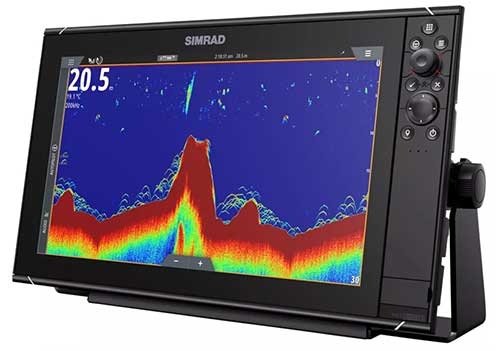
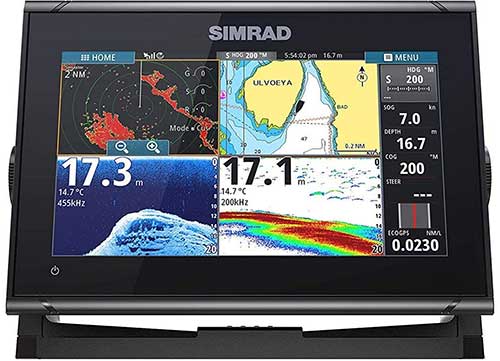
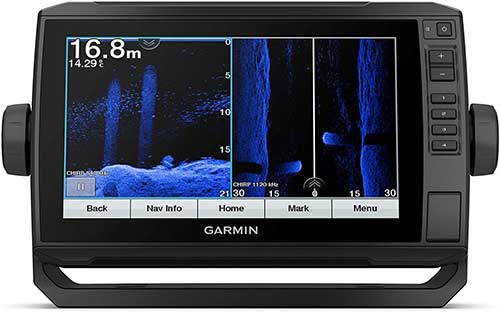
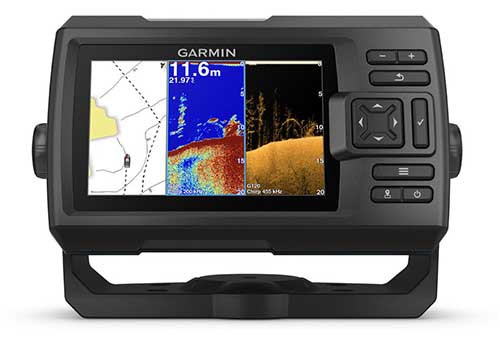
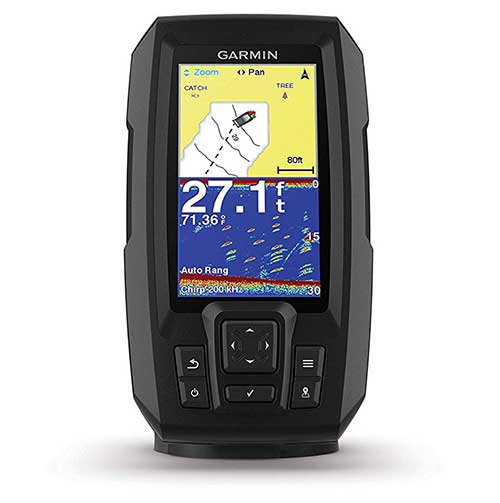
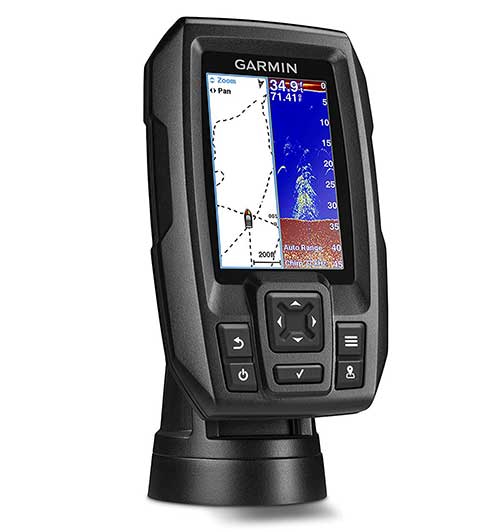
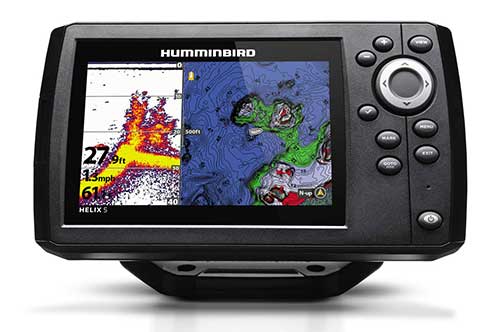
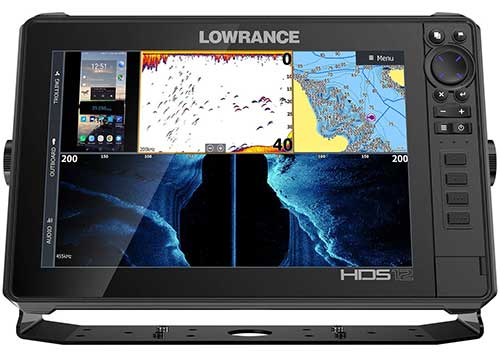
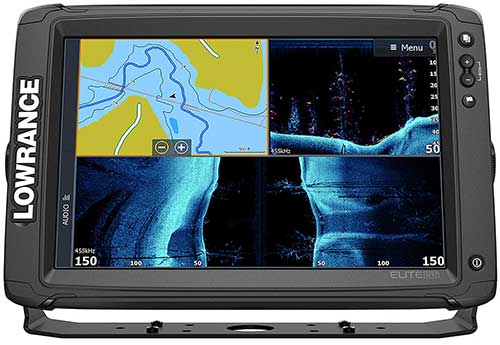
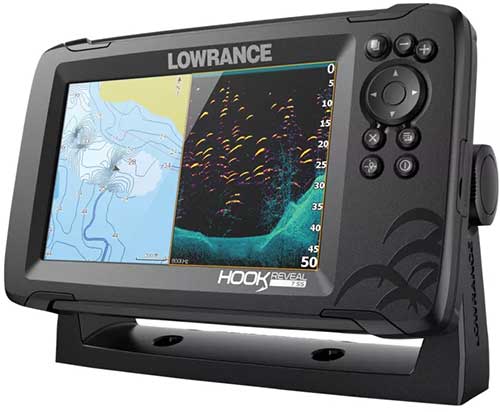
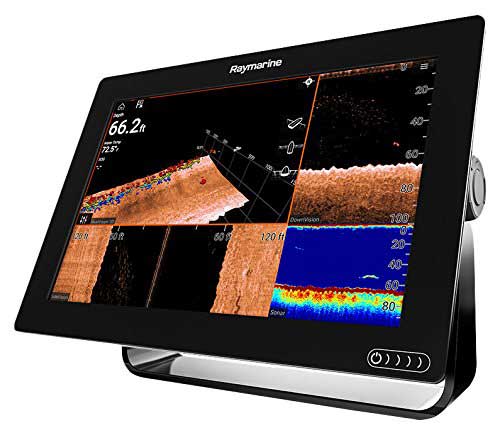
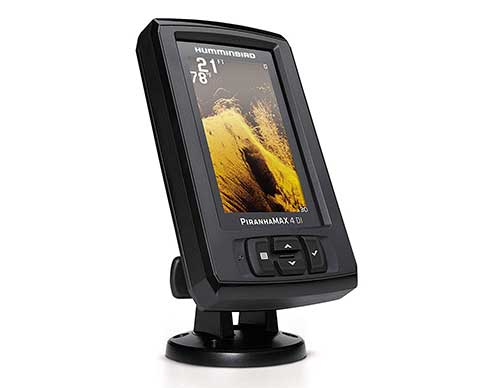
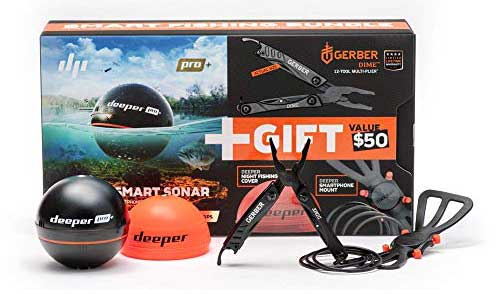
Great article. I first started back in ancient times using flashers, triangulating landmarks on shore to get on your spots. There were even some old gadgets that used radio signals on land to plot your location! It’s a wonder we lived through those adventures!
Now this old dinosaur has to figure out which one of these marvels is best for my type of fishing. I’m wanting a unit that has quality side scan for locating tuna, yellowtail, dodos, and marlin. I am also looking for an audible alarm feature. I’ll also need a quality up and down meter to keep on the depth of the fish as they stack under the boat. I also fish our channel islands for yellowtail, calico, sand and white seabass. I fish rockfish as well but rarely over 350- 400ft. I really appreciate your input and please keep in mind the dinosaur comment was only slightly tongue in cheek. Thanks.
Les Simmons
I belong to a boat club and want to know what is the best option for me to use and move from boat to boat? I need a fish finder and GPS plotter. Any recommendations?
We make a living casting a taped cast net in south ga for shrimp on the bottom of rivers and intercoastal waters. What is the very best fish finder today for that job and the price for the unit? My name is Linker
I would say most fish finders should work. I imaging the depth is pretty shallow. It would just be a matter of fine-tuning the settings and becoming familiar with what marking the shrimp looks like. I have never tried to target shrimp specifically though.
I really enjoyed this posting. I have had a Hummingbird fish finder for 28 years and want to upgrade. The technology has changed so much, or just gotten better. I feel like a fish out of water, pun intended. It’s a lot of information I will have to study more closely. I was watching a Bass Masters Tournament the other day and saw the commercials on TV and realized I was really missing out on getting the right edge on catching some quality fish. I fish small lakes 100 feet or shallower, mostly for Bass and Tiger Muskie. Any suggestions would be welcome, $800 or less.